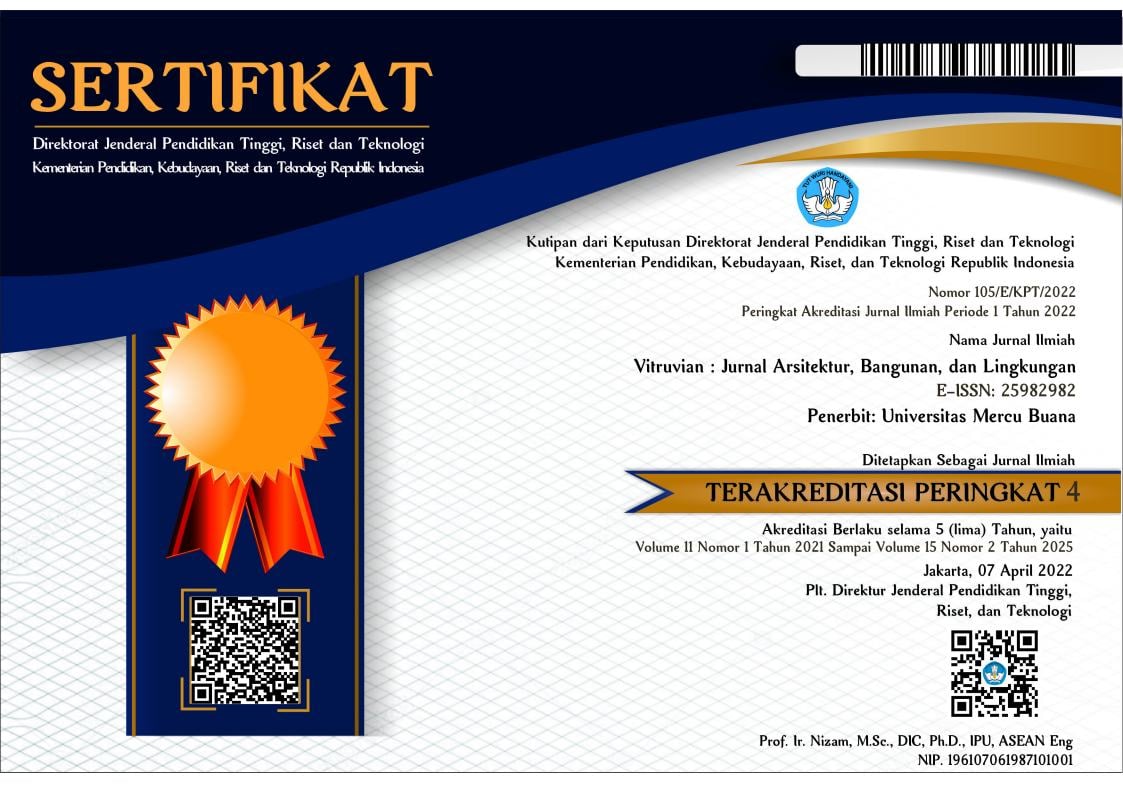EVALUASI KINERJA TERMAL DAN DAMPAKNYA TERHADAP KENYAMANAN PENGUNJUNG MUSEUM BAHARI JAKARTA
Abstract
Keywords
Full Text:
PDF (Bahasa Indonesia)References
Ascione, F., Bellia, L., Capozzoli, A., & Minichiello, F. (2009). Energy saving strategies in air-conditioning for museums. Applied Thermal Engineering, 29, 676–686.
ASHRAE. (2007). ANSI/ASHRAE Standard 62.1-2007: Ventilation for acceptable indoor air quality. Atlanta, GA: ASHRAE.
Australian Government. (2004). Adaptive reuse: Preserving our past, building our future. Commonwealth of Australia.
Balocco, A., & Grazzini, G. (2009). Numerical simulation of ancient natural ventilation systems of historical buildings: A case study in Palermo. Journal of Cultural Heritage, 10(2), 313–318.
Bataille, G. (1930). Musée (Vol. I). Paris, France.
Bellia, L., Capozzoli, A., Mazzei, P., & Minichiello, F. (2007). A comparison of HVAC systems for artwork conservation. International Journal of Refrigeration, 30, 1439–1451.
Cantin, R., Burgholzer, J., Guarracino, G., Moujalled, B., Tamelikecht, S., & Royet, B. G. (2010). Field assessment of thermal behaviour of historical dwellings in France. Building and Environment, 45(2), 473–484.
Corgnati, S. P., & Filippi, M. (2010). Assessment of thermo-hygrometric quality in museums: Method and in-field application to the “Duccio di Buoninsegna” exhibition at Santa Maria della Scala (Siena, Italy). Journal of Cultural Heritage, 11(3), 345–349.
Elovitz, D. (1995). Minimum outside air control methods for VAV systems. ASHRAE Transactions, 101(2), 613–618.
Ge, G., Xiao, F., & Wang, S. (2009, July 27–30). Indoor thermal comfort and energy efficiency of various air conditioning schemes for museum buildings. Paper presented at the 11th International IBPSA Conference, Glasgow, UK.
Gennusa, M., Rizzo, G., Scaccianoce, G., & Nicoletti, F. (2005). Control of indoor environments in heritage buildings: Experimental measurements in an old Italian museum and proposal of a methodology. Journal of Cultural Heritage, 6, 147–155.
Ghbuash, R. (2014, March 18). Interview by Hawra Askari. Women's Museum UAE, Dubai.
Giovanni, L., Audenaert, A., & Braet, J. (2014). Natural ventilation as passive cooling strategy aimed at summer overheating reduction in heritage buildings: The case study of Vleeshuis Museum in Antwerp (Belgium). In The European Conference on Sustainability, Energy & the Environment 2014: Official Conference Proceedings.
Sharif Askari, H., & Altan, H. (2014, November 23–25). Museum indoor environment and their effect on human health, comfort, performance and productivity. Paper presented at SEEP 2014, Dubai, UAE.
Jeong, J., & Lee, K. (2006). The physical environment in museums and its effects on visitors’ satisfaction. Building and Environment, 41, 963–969.
Klenz, P., Larsen, M., Wessberg, M., & Brostrom, T. (2013). Adaptive ventilation for occasionally used churches. In 3rd European Workshop on Cultural Heritage Preservation (EWCHP) (pp. 55–62).
Kusuda, T. (1976). Control of ventilation to conserve energy while maintaining acceptable indoor air quality. ASHRAE Transactions, 82(1), 1169–1181.
Macchia, A., Campanella, L., Gazzoli, D., Gravagna, E., Maras, A., Nunziante, S., Rocchia, M., & Roscioli, G. (2012). Realgar and light. Procedia Chemistry, 8, 185–193.
Maahsen-Milan, A., & Fabbri, K. (2013). Energy restoration and retrofitting: Rethinking restoration projects by means of a reversibility/sustainability assessment. Journal of Cultural Heritage, 14(3), e41–e44.
Mecklenburg, M. F. (2007). Determining the acceptable ranges of relative humidity and temperature in museums and galleries. Smithsonian Museum Conservation Institute.
Michalski, S. (2007). The ideal climate, risk management, the ASHRAE chapter, proofed fluctuation, and toward a full risk analysis model. In Roundtable on Sustainable Climate Management Strategies (pp. 1–19).
Minutoli, G., & Farneti, F. (2009). Natural ventilation systems in historic buildings: Pitti Palace in Florence and Marchese Palace in Palermo. Florence, Italy.
Nicholas, S., Jones, M., & Background, A. (2008, October). NMDC guiding principles for reducing museums’ carbon footprint. UK National Museum Directors Council.
Papadopoulos, A., Avgelis, A., & Anastaselos, D. (2008). Low energy cooling of the White Tower, functioning as a contemporary museum. Energy and Buildings, 40, 1377–1386.
Pateraki, S., Papadopoulos, A., Vasilakos, C., & Maggos, T. (2011). Studying the indoor air quality in three non-residential environments of different use: A museum, a printery industry, and an office. Building and Environment, 46, 2333–2341.
Plenderleith, H. J., & Werner, A. E. A. (1974). The conservation of antiquities and works of art. London, UK: Oxford University Press.
Saraga, D., Pateraki, S., Papadopoulos, A., Vasilakos, C., & Maggos, T. (2011). Studying the indoor air quality in three non-residential environments of different use: A museum, a printery industry, and an office. Building and Environment, 46, 2333–2341.
South West Museums & Libraries Association. (2014, March 4). The importance of museums. http://www.swmlac.org.uk/theimportance-of-museums/
Thomson, G. (1978). The museum environment. London, UK: Butterworth & Co. Ltd.
Wahab, H. A., & Zuhardi, A. F. (2013). Human visual quality: Art gallery exhibition. Procedia - Social and Behavioral Sciences, 101, 476–487.
DOI: http://dx.doi.org/10.22441/vitruvian.2025.v15i2.008
Refbacks
- There are currently no refbacks.
Copyright (c) 2025 Vitruvian: Jurnal Arsitektur, Bangunan dan Lingkungan
License URL: http://publikasi.mercubuana.ac.id/index.php/virtuvian/article/view/34197
Layout Jurnal Vitruvian:Download
Declaration & CTA Form Vitruvian:Download
(WAJIB DI UPLOAD SEBAGAI SUPLEMENTARY SAAT SUBMIT ARTIKEL)
Vitruvian
Program Studi Arsitektur
Fakultas Teknik Universitas Mercu Buana
Jl. Raya Meruya Selatan, Kembangan, Jakarta 11650
Tlp./Fax : +62215871335
Surel : [email protected]
p-ISSN : 2088-8201
e-ISSN : 2598-2982
Website : http://publikasi.mercubuana.ac.id/index.php/virtuvian
DOI : 10.22441/vitruvian
Vitruvian is indexed by the following abstracting and indexing services:

This work is licensed under a Creative Commons Attribution-NonCommercial 4.0 International License.








